Vertical Jump Exercises Without Injury - Part 3 - The Squat

I see varying degrees of squats performed in the gym
. First I see no squats at all. That's a real shame, beacuse they have the title of "King" of the lower body exercises for a reason. The people who don't perform them are easy to spot though, especially from the waist down. Then I see people performing squats badly. This is a bigger heartbreaker because they have the right intention, but as the saying goes the road to hell is littered with great intentions. Lastly I see people squatting dangerously, and I've also seen my fair share of accidents in the gym. So listen up - all of the above can be avoided and you can develop good form and make gains with your vertcial jump exercise programme by following these five pointers.Rule #1 - Use a spotting partner (or two). If you are going to train hard, and preferably to failure at the end of a set, you need to know that you can do so and still get the weight back up on the stands afterwards. If you don't use partners, the temptation will be to exercise slightly less intensely than you can in order to get the weight back up on the last push. Grab a couple of buddies for a few minutes and get them to be your backstop. Return the favour too, and they'll gladly oblige. If this isn't possible use a Power rack, but stay away from the Smith machine is it tends to reduce the effectiveness of the exercise.
Rule #2 - Do not bounce at the end (squatted) part of the exercise. You can perform a deep squat, past the point of quads parallel to the ground safely and without damaging your knee ligaments as long as you don't bounce back up again. You need to keep the strain on your muscles, and away from your joints as much as possible. Plyometric and box jumps involve a different type of movement and are valid vertical jump exercises, but they aren't performed with a heavy bar so don't use explosive and ballistic movements when squatting.
Rule #3 - Use a weightlifter's belt to support your lower back. You must keep your back straight whilst squatting, as the load needs to be supported vertically by your skeletal structure. The squat exercise, when done correctly should place primary stress on your quadriceps, glutes but also on the erector spinae, which extend throughout the lumbar, thoracic and cervical regions in the groove to the side of the vertebral column. There is a bit of controversy about the effectiveness of weightlifting belts, but for the small cost of a belt and also the fact that they don't cause injury makes them a safety favourite.

Rule #4 - Stretch your quadriceps and get the blood flowing to raise the muscle fibre temperature before beginning. This is a real simple one to perform - simply squat without a weight for four sets of thirty seconds each. As in the weighted version, turn your toes slightly outwards and don't bounce your knees. Your objective is to free up and lengthen your hips, hamstrings and quadricpes.
Rule #5 - Repetition is the mother of skill, but those reps need to be done right first time every time. A great way to do this safely is using the wall hug method. This requires no weight and allows you to build good form before the poundage on the bar increases. Stand facing a wall with your feet a little more than shoulder width apart, toes angled out and touching the wall. Place your palms against the wall, moving them up to ear level and then rest your chin on the wall, head up. Now squat down as low as you can without falling backwards. The reference points of chin and toes against the wall mean that you have to perform the exercise with a straight back and knees in line with the toes. Ask a buddy to critique your form, paying close attention to the straightness of your back and alignment of your knees.
Squats are a supreme lower body exercise, and an absolute must as a vertical jump exercise. As I said at the start, it's a pity that more people don't perform them, as they will add power and driving force to your thighs. At the risk of repeating myself, train hard, train intelligently and train safely. Now go do it!!!
by: Glenn Devey Browsing For Bucket Trucks For Sale Bucket Trucks Ala Carte Your Comprehensive Guide to Filing an Injury Claim Some Crucial Information On Auto Loans After Bankruptcy How to grab Cheap Car Insurance Kansas Becoming Legal in Ohio with Auto Insurance in Aurora The Role Of Clinical Negligence Solicitors In Brain Injury Or Spinal Injury Cases The Three s Factors Revealing Advantages Of Having 4x4 Pickup Trucks Dollar Thrifty Automotive Group, Inc. - Swot Analysis - Market Research Reports On Aarkstore Enterpr Tips And Tricks To Avoid A Knee Injury Can I Allow my Friend to Borrow the Car and be Covered with Auto Insurance in Bay? Thinking About Buying that New Hybrid? Take a Look at Auto Insurance in Brooklyn First! Will Your Extended Auto Warranty Cover Your Situation?